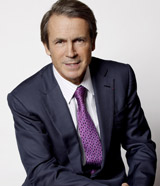Lynda Gratton, Professor, London Business School; Founder of the Hot Spots Movement, a research and consulting team melding both business and academia; and a well known organizational theorist, led a Q&A session outlining whether complexity is really in the minds of top business leaders when managing their companies. Two top business leaders, Rick Goings, CEO of Tupperware Brands, and Natarajan Chandrasekaran (Chandra), CEO and Managing Director of Tata Consultancy, gave her their take on complexity in organizations.

Check all post conference material here.
Lynda: What makes the world so complex?
Rick: At Tupperware, we have 3 million employees worldwide, so we have to change our methods and our business on different levels to adapt to the market.
Lynda: Chandra, what are you telling people about complexity in the world?
Chandra: We are an IT company with businesses across the world. The economies are connected but very different with varying social issues across the world.
In a retail bank, the problems you face today are different to those of yesterday. My father, who was a businessman, would wait for the post and take cheques in person to the bank. Today, I would personally never go to a bank, nor have a relationship with them. The third generation, my son, is now telling me to go into online banking because of this.
Nowadays we all have a real time view of things that we see. This makes things increasingly complex despite the fact that growing a business should be simple. This leads to the dominant question of, how do you simplify things?
Lynda: If everything is peer and group-based, what is the role of a leader? How do you manage as a CEO?
Rick: Yes, you still need leaders. There are relationships and values that come with being a leader. For example, Twitter interactions can be seen as the bottom, then mail, and perhaps a hand written letter. This shows that we are still in need of personal relationships and we [Tupperware] treat our 3 million employees all as individual entrepreneurs, our number one focus in the company is on people.
People will work for money but they will die for a cause, therefore, we strive to hold them together through « purpose ». In order to do so we have created a replicable business model like McDonalds. Every successful business model works until it doesn’t and it is in that instance that you have to change your model.
Lynda: How does Tata think about complexity?
Chandra: Most of our employees are engineers. We have an intellectual workforce predominantly consisting of young high achievers. In our company leadership is about using the energy brought forward by the staff within our « realize your potential » concept. Everything we do is about enabling people to do the maximum and to push themselves. We now have a social media platform of 120 000 people in 3000 communities to share ideas. I was worried when we started the platform, however, it has proven to be self-regulating and the users talk about serious topics.
Within the company (Tata consultancy) greater learning is required for our senior members, as one of our main focuses is on leadership and enabling communication by aiming to kill the hierarchy. With the advent of mail we added the number of people who validated requests, this proved to be quicker, yet the hierarchy remained the same. Since then the concept of hierarchy at work has changed and today, we trust people at contact point to make the right decision as opposed to the previous hierarchy.
Lynda: What are the ten PRACTICAL tips for managing a complex organization?
Rick: We talk about Pareto’s principle and the fact that most things do not matter. Therefore, it is up to you to decide what the things that truly matter are, by doing so we avoid wasting time and resources.
Curt: I try to make things very visual. We have a room where we meet with people to talk about what their role in the business is, this method creates a lot of data and information but also provides great visual information about the team.
Clas: When you make intelligent use of external networks, they will work more quickly at problem solving than any hotline.
Chandra: You can easily get carried away with technology, so it is important to sit back and think about how your business will work in the context of new technologies. For example, how can you fully harness the power of a mobile phone for your business?
You also need to know how to listen in business, at Tata we have a listening platform to find out what is going on, by doing so we keep the communication in our business ecosystem dynamic. It is crucial to find the best communication system for your organization.
Clas: You also need to think about analysis and prediction, the volume of data is so vast, you cannot solely rely on your gut feeling.
Rick: Diversity is also a crucial aspect in companies today. Often US companies divide their business into « core business » and « rest of the world». At Tupperware the senior management team includes a Brit, a Belgian and a German.
“They see things that we don’t see from the US and they understand how this works on the ground. Because of this we know far more about the business.”
Yves Doz: One final point is the sharing of dialogues. Sharing dialogues allows you to confront and generate new ideas, whilst at the same time requires you to take the time to look at people’s assumptions, and oftentimes involves taking the risk to get into very open discussion.
Access all GlobalEd conference articles here.

















Reblogged this on Web Bloggers Green Business 2.0+.
Pingback: Highlights from the Thinkers 50 Awards « The Hot Spots Blog
Pingback: Simplifying Future-Work Part 1 - Forbes